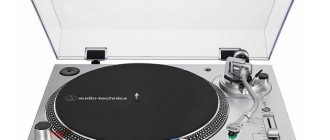How to choose vinyl 3
In this article we will talk about the main problem that concerns music lovers who are passionate about vinyl, namely the choice of original editions of the 1960-1990s. Despite the significant increase in the cost of early pressings of popular albums, today you can still buy great-sounding analog-era records for reasonable money. And we will try to help you with this.
It must be said that the very definition of an “original” record is quite vague. Should only the first press with the very first dies be considered original? What if an additional edition was printed six months later from the same matrices? Or was the first edition unsuccessful? The same applies to subsequent press releases that were released in the years following the release date. Even when printing from the second or third generations of matrices, provided the quality of the original recording was high, the resulting records were significantly superior in sound quality to most “audiophile” reissues. This is affected by the age of the film, the higher qualifications of sound engineers of that time when working with an analog signal, and other factors. Therefore, for the purposes of this article, we will consider records released in the first and two or three subsequent editions. Most often, the first and second presses of an album will fall under this definition. We will also touch on the topic of regional publications.
So how to choose? Let’s immediately make a reservation that our article is intended for those readers who buy vinyl for the sake of high sound quality, so in our recommendations we will follow precisely this criterion, and not the “collectibility” of any press. In addition, we will give some simple tips on how to determine the condition of a record with a fairly high degree of accuracy if you do not have the opportunity to listen to it before purchasing.
Choosing a good sound
It goes without saying that records from the golden age of audio are recorded and sound different. They have only one positive feature in common - they were all originally recorded in analog, so even the second or third presses sound significantly more pleasant than almost all digital reissues of the same albums. What should you pay attention to when choosing?
1. Country of publication
If you choose an album by an English artist, then, of course, it is more logical to look for an edition from Foggy Albion. There are rare cases when certain groups recorded and released records in another country, but they do not have an impact on the overall statistics. Most often, the highest sound quality is demonstrated by albums published in the artist’s “place of residence.” However, you can save a lot of money by buying expensive bands like Jethro Tull, Uriah Heep, Led Zeppelin, The Beatles, etc. If you just need a good-sounding record from a given group, released entirely in analogue, then you can easily take a German or French press, which will cost significantly less than an English one, but will not sound much worse. Moreover, in rare cases, it is foreign editions that turn out to be better than their “native” ones in terms of sound, as happened with the Deep Purple album “In Rock” - the German press on the HörZu label leaves no chance for the English original.
We also warn against the thoughtless purchase of Japanese presses by European and American performers. Yes, there are masterpieces among them, but very often Japanese companies did absolutely their own mastering in order to please the specific perception of music by the residents of Japan. And the result is sometimes very different from the original sound of the record. Fans of The Rolling Stones, The Beatles and many other English groups who are accustomed to buying American-issued records should be prepared for similar surprises. Sometime before the mid-1970s, many albums released overseas by English pop and progressive rock stars were subject to “rethinking,” not only in terms of the track listing or the title and artwork of the record, but also in mastering. A favorite pastime of American publishers was to lower the bass level on records, they say, portable vinyl players could not cope with the width of the track. The first albums of Led Zeppelin, Deep Purple, Black Sabbath, The Beatles and many others suffered from their skillful hands. Therefore, before you shell out your hard-earned money for American records from your favorite English bands, try to find information about how much they have suffered from “optimization”. By the way, from this point of view, German or French publications are much more reliable.
2. Secret symbols
Here we are already entering the territory of collectors, for whom the difference in one digit in the matrix number, stamper letter or dot in the inscription on the label changes the cost of the record several times. However, we are only interested in sound, and therefore we will give only a few basic signs of good-sounding records.
a) Inscriptions on the runway.
Look for the signature of the engineer who cut the varnish disc on the rung of the record. Often they signed with initials - RL (Bob Ludwig), GP (George Piros), or pseudonyms. The most famous fan of pseudonyms is George Peckham, he signed himself as Pecko, Pecko Duck, Porky, Bilbo. In general, the very fact that the disc was signed by an engineer indicates that he is proud of his work and wants buyers to know who was responsible for the sound quality. If there is no signature, look for a stamp from a well-known mastering studio - Sterling, Bell, etc.
b) Matrix numbers.
They usually serve to determine the pressing date and whether a particular record is a “first press.” It is useless to deny that the first presses sound better than all subsequent ones, but the difference in sound rarely justifies the difference in price, which can reach tens of times. True, this rule only applies to collectible labels and cult bands like The Beatles or Led Zeppelin. It is completely useless to look for the first presses of pop groups or performers who were published in millions of copies. Try to find a record, for example, The Police “Regatta de Blanc” or Michael Jackson “Bad” with the first matrix numbers. It can fall into your hands only by chance. Therefore, we recommend approaching the issue wisely - if the matrix numbers are not expressed in two digits, and you see numbers like A3 or 4U in front of you, you can safely buy the record.
c) Inscriptions on the envelope.
They will help determine the country of publication - it is usually indicated at the very bottom on the back, as well as the period. For example, if they try to sell you Led Zeppelin III with a barcode on the back of the envelope, telling you that this is close to the original edition, then you can safely turn your back on the seller - barcodes appeared on envelopes only in the very late 1970s - early 1980 -s.
d) Inscriptions on the label.
There is a whole secret layer of knowledge that allows us to determine the originality of the publication based on the design of the coin, the presence or absence of inscriptions or numbers, font, word orientation, and many other characteristics. It only makes sense for collectors to think about this; this knowledge helps them purchase real records at the right price. We will say the following - there is a huge amount of reference information on the Internet, thanks to which you can immediately determine the approximate period and country of publication of the record by the color and design of the label. This is especially important when purchasing remotely. At least this way you will save yourself from buying a reissue at the price of the original record.
3. Vinyl mass
If you have the opportunity to hold the record in your hands, then by its weight and the type of tracks you can roughly determine the potential sound quality. The wider the tracks are cut, the greater the chances of getting deep bass and good volume. Heavy records from the 1960s also make for good sound. We recommend avoiding Dynaflex releases - thin flexible records from the 1970s are characterized by a compressed and dull sound, as well as colored vinyl - as a rule, such layers exhibit an increased noise level.
Assessing the condition
Obviously, even a luxurious “pervopress” with wide tracks and correct matrix numbers will be impossible to listen to if, in addition to music, it also contains the song “Mom Fries Scrambled Eggs,” which consists entirely of crackles and clicks. It is clear that if you have the opportunity to put the record under the needle before purchasing, then almost all questions will disappear by themselves. There are, however, cunning sellers who turn the high frequency level on the amplifier down so that the crackling noise is not heard, but there are very few of them. But if the condition of the record has to be assessed “by eye”, then we have some simple and useful tips.
a) Scratches and abrasions.
It all depends on what caused the damage. If they come from the fact that the record was often taken out and put back in a paper sleeve, then there is a chance that when played with a good stylus with a complex profile, they will not be heard at all. If the damage is deeper, but there is very little of it, then you can think about restoring the damaged groove walls using, for example, a toothpick. Of course, if the record is severely scratched over its entire area, it will no longer be possible to restore it.
b) Spider on the spindle.
You need to take a close look at the area around the center hole of the record. If the walls of the hole are damaged, and the surface of the penny around it is dotted with traces of inept laying of the layer on the support disk, then, most likely, you have heavily sawn vinyl, even if there are no scratches on it.
c) The color of the plate.
A new or well-preserved record should have a black glossy surface. Even if outwardly there are no scratches or damage on the plate and label, but the surface itself looks gray, then what you see is a neatly sawn-down record with the walls of the grooves already destroyed. There was nothing left of the sound there.
Unfortunately, there are situations when it is almost impossible to visually determine damage. This happens when a record is played for a long time with an incorrectly tuned or chipped stylus, which leads to the destruction of the grooves, especially on the last tracks. Or, for example, it was subjected to prolonged exposure to elevated temperatures, causing the smallest particles of dust and paper envelope to become firmly glued into the tracks. It is also not always possible to confidently determine the presence of eccentricity, although this is the lesser of the evils.
Let us remember that in the first part we looked at vinyl editions of new albums, and in the second part we looked at modern reissues of classic albums.
We hope that this series of articles about vinyl will be useful to you when adding to your music library.
We will continue to regularly introduce you to new products on the market for gramophone records and equipment for playing them. Discuss on the forum
Secret Service of Vinyl Maniacs, article. Magazine "Audio Store"
Look, there is a book by Ian Peterson, also about Island, a serious work. But it has a big drawback - Ian focused only on the design of the label. When I examined the records, I realized that they were made at different factories, although they all had the same design. Labels were printed for future use in large quantities and could be used for a second printing and beyond. You have a Michael Chapman record on Harvest, where on one side the label is without the EMI logo, and on the other with the logo. And how can we determine this?
Save and read later -
Yuri Grishin is a one-man vinyl research institute that has caused the amazement of Western collectors and the irritation of Russian sellers, the author of five books that have turned the existence of vinyl collectors into hell. If earlier we were all sure that we had a collection of the very first and most unique publications, today our hand tremblingly reaches out to the book to check - is this so? And we are often forced to admit: we still don’t know much and the search for the real original is not over yet. Does he know?
Yuri Grishin was born in Moscow in 1959, graduated from the Military Music School and the Institute of Asian and African Countries at Moscow State University. He heard his first Western record at his friend’s house at the age of eight, and it is not surprising that it was The Beatles. He played bass guitar in the school ensemble for songs by B0lack Sabbath and even King Crimson; in the army he bought his first record, which turned out to be the album of the Grand Funk Railroad group “Born To Die”. Already at the institute, I first came across a vinyl market; in the mid-90s, I became one of the first to transport records from Sweden and the UK, and opened my own store on Leninsky Prospekt. But most importantly, he, perhaps the first in our country, realized that he knew nothing about these same records, and began historical research, which resulted in five books on the releases of the labels Island, Harvest, Charisma, Vertigo, plus the website collectable-records.ru. And it looks like that's not all.
AM What is the circulation of one book?
— A thousand pieces, although 927 copies are handed over.
AM Where do more books go, abroad or to the domestic market?
— I didn’t specifically count, but I think it’s approximately equal.
AM In which countries do they buy?
— One of the large distributors is the Dutch company Clear Spot. And they also buy from stores from Germany, Norway, Finland and Japan.
AM Do collectors just order?
- Certainly. I sent parcels everywhere - Poland, the Czech Republic, Switzerland, France, Spain... Almost all of Europe, and, of course, the USA. Recently, customers in South America have become more active. We ordered several books from Australia.
The famous "spiral" label Vertigo,
which featured Juicy Lucy,
Black Sabbath, Cressida, May Blitz,
Uriah Heep, Patto, Catapilla…
AM How did you suddenly become interested in such things as the first press, the original, the country of publication, the label? After all, no one cared then, the main thing was that the record was branded and new.
— This was already in 1996. I went to Sweden with a friend to buy records. I sold the car and we drove off. And there in the stores I noticed that some records are in dollar boxes, and some are hanging on the wall and cost much more. I realized that there were more things to do with records than just the band name and the album. In addition, I saw the seller had a thick book “Record Collector”, which he sometimes looked into and looked at something there. On my next visit to Sweden, I immediately went to the bookstore and bought exactly the same one, although it was not cheap. In the evenings, returning to the hotel with shopping, I checked the records with the reference book. And then I saw that this, for example, was the first press and it was published on this label, but this was the third edition, and their prices were different. I also realized that I had to learn to understand this - all the designations Pink Island, Black Block Logo, Palm Tree Logo didn’t mean anything to me, but I understood that they were there for a reason. At that moment, I was of little interest in the classification and history of a label or any publication; I wanted to learn how to correctly choose the first edition from a bunch of records.
MA Why was this necessary? Were the first editions already more expensive in Russia?
- You know, yes. Some sellers and collectors began to pay attention to this, the words “first press” and “original” quickly came into use, and prices for them rose noticeably. Although, as I now understand, these things were interpreted very loosely, and primarily out of ignorance. Then I came to London for the first time and when the salesman at the Daddy Cool store started carrying stacks of records for me according to the list, I was already selecting, as it seemed to me, the originals. The seller was still surprised, they say, they are all original English? I tell him that no, I need the originals, that is, what was published in the very year indicated on the record. He smiled: come on, choose.
AM When did you start paying attention to matrix numbers?
“At first it looked like some kind of stupidity, and still few people understand this. After all, in order to confidently distinguish the first presses from the reissues by matrix number, you need to know the history of the production of a particular record. For example, the matrix with the first number was rejected at the preparation stage and was taken for circulation with the second number. In this case, you can search until you are blue in the face for the option with the first number, although it simply does not exist. Then, some records were re-cut and again given the first number, and so on. But in 1999, everyone suddenly began to look smartly at the stamps on the run-out of the record and look for the first number. I had a store on Leninsky Prospekt. A buyer comes, looks at the Ringo Starr record for a long time, and then declares: this is the second number, this is not the original. And what should I answer him? I come to Gorbushka, and everyone is walking around and looking at the matrices. And then my friend Lesha Gladyshev says to me: “The devil once pulled me to point out the matrix to one of the guys, there were some ones there, which means it’s like the first press. And now no one buys records if there are two or more on them. Everyone is sure that there must be a number one.” So he himself, without understanding anything about it, started such a legend, for which everyone began to pay. By that time, I was maintaining a database of various publications and realized that I also needed to record numbers, although no system of this could be made for a specific record. First you need to know its history, but where can you get it?
The first disc in the company's discography
Island is published with a black label,
printed on white, after which it began
the first episode of the legendary “white” Island
AM But on the run it’s not just the matrix number, it shows all the stages of making the record. Then you need to understand this, but many still have little idea how records were made back then and what kind of numbers they were, they just learned the word “matrix”. When did you become interested in manufacturing technology?
— This was already in 2005. I started reading foreign forums where people were arguing about the different engineers who did the mastering. Then I learned that there is a profession that is extremely important for the process of making a record - a cutting engineer, that is, a person who cuts a varnish disc. The sound of the record depends on his unique skill, and it turned out that there were a number of cult engineers for whom there were queues. We can often find their initials on the same rung. I was lucky to write with one of them - Denis Blackham. He explained many things to me. And when you know the process of making a record first hand, it becomes much easier to read the secret script of numbers and letters on the run.
AM Was this a one-time conversation?
- No, we still correspond with him. Questions arise constantly, and he kindly answers them, explains everything, if, of course, he knows the answer. I asked him whether there should always be the first matrix? He replied that no, not always, the disks were recut for various reasons. For example, the producer didn't like the song sequence at the last minute. John Dent told me the same thing.
AM And this is just one component of the record's publishing history, right?
- Certainly. Any collector who is trying to collect vinyl seriously needs to understand the manufacturing process. But besides this, it is imperative to know the history of the label itself - how it was founded, who owned it, who it was resold to, who distributed its products in different periods in a particular country. All this is reflected on the label and sleeve, and based on this data, it is highly likely that you can identify the first press that everyone now so wants to have on the shelf.
AM When did you launch the website collectable-records.ru?
"Pink with an eye" Island,
especially loved by collectors,
who are looking for the first editions of Jethro Tull, Traffic,
Art, Free, Tramline and other cult records of this period
- In 2001. I wanted to make an accessible resource where you can see what a particular record looks like. I needed this myself too. Many records passed through my hands, it was impossible to keep everything in my memory, but here you could always see how and what. Other enthusiasts began to help me and sent me scans of labels from their collections. But most importantly, by 2004 I realized that all this information needed to be classified somehow. When it looked like system information, I tried to make the site a paid site. It turned out that a lot of people use my site, but they immediately accused me of money-grubbing. Western users immediately signed up without any questions, but for a long time I received letters and comments from ours, saying, what is this, the information should be free and in general your site is complete nonsense. But if it’s nonsense, why are you so worried?
AM When did you decide to make your first book and why did you choose Island?
— The decision came somehow by itself. People who collect records have a normal attitude towards all sorts of reference books and catalogs in printed form. Why Island? Well, you yourself bought the record on the “white” Island, and I first saw it from you. I was very interested in what period this was. Even in Record Collector magazines, the history of this label began with the “pink eye” period. Then information appeared about the first issues, but no one wrote anything definite anywhere. I decided to look into it, especially since by 2005 a lot of necessary material had accumulated. After all, there have never been such books, although records from Island, Harvest, Vertigo, Charisma have always been on many collectors’ lists of most desired ones.
AM But how can you describe the label’s huge discography without holding the records themselves in your hands?
- This is the main problem. Almost all the records I write about were bought by me, sold, to buy others again, and so on, an endless process. Although my comrades bought a lot for themselves and gave it to me for description without any problems. Thus, almost all the records described in the books passed through my hands. Expensive, tedious, but very exciting. To be honest, in the first book about Island, many records are missing; at that time I could not find them. But in the second updated edition, which was published in 2011, the entire history of Island is already closed. I was missing five records, but my Norwegian friend, who had these records, helped and sent me photographs.
The first disc in the company's discography
Island is published with a black label,
printed on white, after which it began
the first episode of the legendary “white” Island
AM Do you remember how I completely accidentally bought the very first issue from the Island discography on a black label, although before that we had already seen the same one on a white one? We have never seen anything like this before. Do you think the one on black is the very first?
- Probably so, although there is no direct evidence. But the first single Island was also released with a different label color - gold, and then white came. Apparently Chris Blackwell had not yet decided on the design of the label at the very beginning, so these were the options.
AM How was the first book received by collectors?
— Foreign collectors, frankly, gasped in surprise: some Russian was telling them about their own records. We bought it warily at first, but when we saw it, we started ordering it. Rave reviews came in. Ours were reluctant to buy at first, saying, well, what could there be? Our man always believes that he knows everything and no one else will tell him anything new. Sellers and store owners treated the book very carefully, they were afraid that now everyone would refer to it and it would be difficult for them to sell. But then everything fell into place. I don't think the book hurt anyone. In the same stores that were wary of the book, you can easily buy it. But most importantly, no one challenged the classification I proposed. The only thing where I made a mistake then was the Art group's record. But this has been fixed in the new version.
AM When did you realize that record releases differ depending on the factories where they were made, and which one should come first?
"Pink" label The Famous Charisma -
These are the labels on the first editions
Van Der Graaf Generator, Rare Bird, Genesis,
Atacama and even Monty Python
— Look, there’s a book by Ian Peterson, also about Island, a serious work. But it has a big drawback - Ian focused only on the design of the label. When I examined the records, I realized that they were made at different factories, although they all had the same design. Labels were printed for future use in large quantities and could be used for a second printing and beyond. You have a Michael Chapman record on Harvest, where on one side the label is without the EMI logo, and on the other with the logo. And how can we determine this?
AM How do you determine?
— I started paying attention to the relief of the vinyl under the label. Each plant has its own so-called face - roughness or smooth surface, number and size of rims. You don’t even have to touch it with your fingers; everything can be seen in a good photograph. And now I know which record was printed at the Philips plant, and which, for example, at British Gramophone or Ariola. All factories have their own unique relief under the label. If you know which factories opened when and which companies placed orders there in which years, you can build a logical chain. I almost succeeded, the most difficult moment was the transition from one plant to another.
AM Are there any other subtleties?
— For example, tax codes, which were also stamped on the vinyl surface under the label. It’s easy to know when they appeared and when they were cancelled. But there is no single recipe, the originality of a record can only be determined by a combination of features - the design of the label, the inscriptions on the label, the structure under the label, the sleeve... In addition, some records also have their own stories, as, say, with the second album of Led Zeppelin - all this a leapfrog with the title of the song “The Lemon 5ong”, with an error in the title of the song “Living Loving Maid”, which on the very first press was listed as “Living Loving Wreck”, but these things have already been described in many publications, you just have to ask.
AM And now the main question: does all this fuss with the definition of the first press have anything to do with sound? Does the original sound better than the reissue, isn't that a myth?
Harvest Label,
which released Deep Purple albums,
Pink Floyd, Syd Barrett, Bakerloo,
The Edgar Broughton Band and many others
— I’m not the greatest expert here, but I can say that, of course, most often the first press sounds the way its creators intended. It sounds the way the first buyers heard it, that is, this is the original sound of the record. When reissued, it changed depending on the technical capabilities and requirements of the time. New sound devices appeared, they tried to modernize, improve the old sound, and so on, sometimes re-releases from other countries sound better, such as Deep Purple “ln Rock”. But here anyone likes what, although many still prefer the original sound.
AM But you don’t compare sounds?
- No, I have another task.
AM You have already published five books, built coherent systems for four labels. Aren't you tired of digging into this further?
- No. There is still a lot I don’t know, and learning new things is very interesting to me.
AM Then what's next?
— I want to make a series of books on the rarest and most collectible records, regardless of the label. I dream of dealing with the Decca company, although it is still a very difficult topic. It would be interesting to do a book on the history of the record industry in Britain from the 1960s to the 1980s. In general, there is something to do.
AM Do you think many people are interested in this?
— This is interesting primarily to me.
Prepared based on materials from the magazine “AudioMagazin”, No. 5, 2011 www.audiomagazine.ru
This article has been read 32,456 times.
The article is included in the sections:
Interesting things about sound
Vinyl records. History of formats
If you're just starting to build your own vinyl collection, then it's time to figure out what kind of records there are and why they are like that?
7-inch records: weight, features, history
As the name suggests, they have a diameter of 7 inches - that's about 17.8 cm. Historically, records have been measured in inches, even in countries with the metric system. Their small size makes 7-inchers very easy to store. The weight of such a disk is only about 40 grams. Such records are listened to at a speed of 45 rpm. Due to the nature of their size, one side usually fits 3-5 minutes of music, that is, one composition.
Such records were first released in 1949 by RCA Victor. At that time, they became a more durable and high-quality alternative to 78 rpm shellac discs. Since most often only one musical composition could be recorded on one side of such a record, they began to be called singles. Interestingly, this name was soon transferred to the format of such a recording itself - this term began to be used to refer to recordings released before the artist’s main album. They served as a great way for artists to test listener reaction to a couple of hits from the album, as well as promote a future release. And to do this, it was not necessary to immediately release a full album, the production of which requires a lot of money and effort.
12-inch records (albums): weight, features, history
These records are also named for their diameter, which is 12 inches. One of the first LP records was presented by the same company RCA Victor in 1931. To this day, this format of vinyl discs is considered the main one in vinyl collections. These records are larger and heavier: they usually weigh from 80 to 180 grams, but among them there are real heavyweights with even more mass.
Vinyl record 7RAY feat.
Triple Ace - Jazzy Zoetrope In general, today the standard value for modern vinyl of good quality should be considered a weight of 180 grams. 12-inch vinyl records are often called LPs, which stands for "long play." This is due to the fact that these discs can store more songs than any other (besides 7-inch singles, there were also 10-inch records on the market, but we won’t go into detail about them). It was LPs that began to be called “music albums,” which emphasized their status as a complete work of art. They contained all the compositions recorded by the musicians and were accompanied by a cover specially made for them. However, there are also 12-inch singles (albums with one track on the side), but such records are usually with dance music and are produced mainly for DJs.
Does the weight of a record affect its sound quality?
There is a long-standing debate about whether heavier records produce better sound quality. However, those who argue that “heavy” vinyl sounds better often cite less noise, deeper bass, or overall better sound as arguments. In fact, in many cases, heavier 180 gram records do have better sound, but not at all for the reasons listed above, or even because of weight at all.
The fact is that vinyl producers usually approach the production of heavy 180-gram records as responsibly as possible - this applies to both mastering and the selection of the musical material itself. It is believed that these discs are for music lovers who are most demanding in terms of sound quality. And that's why records like this usually sound really great.
Durability
Another reason why heavier records are preferable to have in your collection is their durability. Records that weigh over 150 grams, such as the new 180 gram and 200 gram releases, are much more resistant to damage than lighter records. Another advantage of heavier vinyl is that it resists deformation better. A standard 150 gram LP will be stiffer than a 40 gram 7-inch single, and 180 gram and 200 gram records are usually the strongest.
This means that "heavy" records will be much less difficult to handle - but always make sure that the discs in your collection are stored correctly - in an upright position and not exposed to heat.
Discs are spinning: vinyl connoisseurs' favorite records
Peter Shinawatra
co-owner of the DiG store
leader of the group "Veterok"
Vinyl records continue to be purchased because of new emotions. Firstly, the sound is different - if you listen to your favorite song on a good player, which you have already played a thousand times on your computer, you will feel the difference. It will not be the most obvious, but other shades in compositions appear precisely because of it.
Secondly, the surroundings themselves are important. It's always a pleasure to collect beautiful and well-made items. Plus, old or new players, amplifiers, and speakers give the room its own atmosphere. Listening to music on vinyl means sharing with other people and with yourself special sensations, built and created on halftones, on a certain sophistication.
Fever Tree
Fever Tree
Album by a late 60's psychedelic rock band. The record opens with the epic intro of Imitation Situation 1, followed by songs recorded according to the canons of 1968 with a compacted and polluted sound. The most hit of them is San Francisco Girls (Return of the Native).
listen online
Albert One
Turbo Diesel
An ingenious musical canvas in the Italo-disco style, where the author lists all the coolest car brands in the verses: Volvo, Volkswagen, Mercedes, Bentley and others. The song became a hit, and it landed Albert One as a headliner at major festivals outside of their native Italy.
listen online
Los Bitchos
The Link Is About To Die
Dance instrumental single from five girls from London. The main guitar bridge has a subtle British rock/pop musician Phil Collins vibe to it, and the percussion makes the song sound very light and fiery. The group itself states that it plays in the Latin American style of cumbia. The vinyl with the single can no longer be found, I asked them on their personal Instagram - they replied that the edition was sold out. We'll wait for the re-release.
listen online
River Yarra
FrogMania
Light trance, I love the track Prog Frog - it’s great to work with or drive a car on the highway at night. The sound of croaking frogs is very exciting.
listen online
Ry Cooder
Paris, Texas (Original Motion Picture Soundtrack)
A beautiful soundtrack for a wonderful film with the desert landscapes of America. The main parts are played on an acoustic guitar. Great music to have a good weekend at home.
listen online
Zemfira, Kedr Lebanese and Madvillainy 2: the most anticipated albums of 2021
When will Zemfira's album be released? (Very soon!) What's Muse and Kendrick Lamar up to? Will Rihanna and Frank Ocean return? Time Out talks about the albums that will be listened to and discussed in 2021.
Read the article
Ilya Kot
administrator of the “This is Vinyl” store, moderator of the music department of the comic book store “Chuk and Geek”, vinyl collector and DJ, bass player of Total Rejects, organizer of the Make Garage Punk Again festival
About ten years ago, many perceived the return of vinyl almost with a chuckle. To collect bulky, dusty music libraries in the era of iPhones and high-speed Internet? Fad, retrograde, fashion, snobbery or a strange hobby on the verge of a foul like philately. Now vinyl, it seems, has returned to every self-respecting home.
Last year, owners of vinyl records clearly found themselves in a more advantageous situation than subscribers to streaming services. The colorful full-format design compensated for the lack of both aesthetic and tactile sensations. In the atmosphere of lockdown, I wanted to listen to my own music more thoughtfully than to swim in the boundless ocean of streaming.
Don’t forget that a record collection tells a lot about its owner. This is not just an abstract set of favorite music releases, but also a human story, quite comparable to a family photo album. I think collectors spend many happy hours going through what they collect and reminiscing about places, moments, and people.
To once again remind you that vinyl is not frozen in the past, I compiled my own top list from young domestic bands - they are being released on vinyl here and now.
10 years of life. How the Moscow concert scene has changed
Bicycles for Afghanistan
“Hide and Seek”
A wonderful, thoughtful and bright album with many memorable melodies. An incredible amount of time, effort and love was invested into the release - and you can hear it.
listen online
Komsomolsk
"Near Light"
This band is always interesting to follow, and the latest album is very different in mood from the previous ones. I would also like to note the They Live label, which released the record: the guys release not the most obvious, but very high-quality music.
listen online
Supergoats
Two-chord electric delight. Bold and fast, stylish and loud, fun and scary.
listen online











